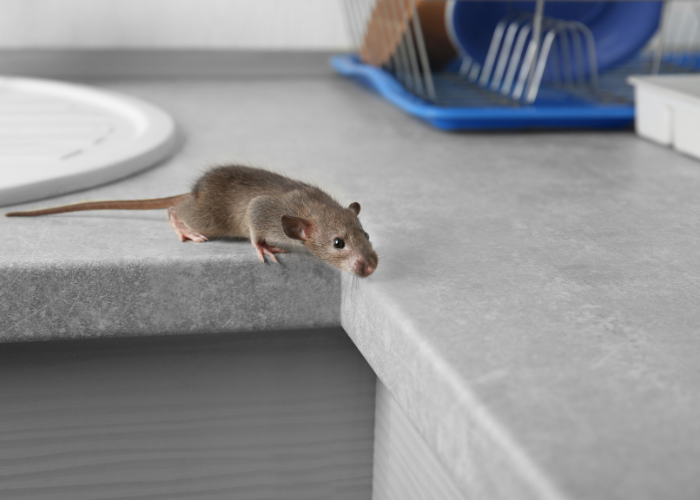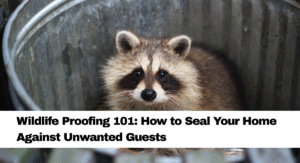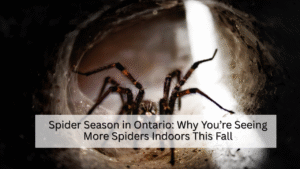You hear scratching behind a wall late at night. Maybe a tiny squeak. You pause, hoping it’s nothing, but deep down, you know what it is.
A rodent has moved in.
It’s not a pleasant thought. Mice and rats are standard in Canadian homes, especially when the temperature drops. But here’s what surprises most people: while both are rodents, mice and rats behave very differently. And knowing which one you’re dealing with can save you time, stress, and money.
Let’s break down how to tell them apart, what attracts them, and most importantly, how to get them out and keep them out.

Why Rodents Invade Homes
Mice and rats don’t invade because they like you. They invade because they like what you have: warmth, food, and shelter.
As soon as outdoor temperatures start to fall, they look for dry, cosy spaces to build nests and raise their young.
Houses, garages, and even office buildings are perfect. All it takes is a hole the size of a coin for a mouse, or the size of a thumb for a rat. Once inside, they hide behind walls, under floors, and near appliances, anywhere warm and quiet.
The truth is, once they’re in, they don’t plan to leave on their own.

Signs You Have a Rodent Problem
You might not see the rodent itself; they’re nocturnal and avoid people. But the signs are hard to miss once you know what to look for.
1. Droppings
Tiny dark pellets along baseboards, cupboards, or near food packages are the clearest sign.
Fresh droppings are dark and moist; older ones turn gray and crumbly.
2. Gnaw Marks
Mice and rats need to chew constantly to wear down their teeth.
You’ll see marks on food containers, wires, furniture, or door frames.
3. Sounds in the Walls
Soft scratching, scurrying, or squeaking, especially at night, often means activity behind walls or ceilings.
4. Grease Trails
Rats in particular leave dark, greasy marks along walls and pipes as they follow the same paths repeatedly.
5. Nests
Made of shredded paper, fabric, or insulation, usually tucked behind appliances, attics, or basements.
6. Strong Odour
A musty, ammonia-like smell builds up in enclosed areas where rodents are active, especially if there’s urine buildup.
If you notice even two or three of these, you likely have an infestation starting or already established.
Why Rodents Are a Bigger Problem Than You Think
Rodents might look harmless, but they carry serious health and property risks.
- Health Risks: They can spread salmonella, leptospirosis, and hantavirus through droppings and urine.
- Allergies: Their droppings and fur can trigger asthma in sensitive people.
- Fire Hazards: Mice and rats chew electrical wires, which can spark and cause fires.
- Contamination: They gnaw open food packages, leaving bacteria behind.
The longer they stay, the more damage they cause. That’s why quick action matters.
How Rodents Get In
It doesn’t take much. A mouse can squeeze through a gap as small as a dime. A rat only needs a space the size of your thumb.
Common entry points:
- Cracks in the foundation
- Gaps around pipes and vents
- Loose siding or shingles
- Garage door corners
- Dryer vent openings
- Utility line gaps
If your home is older, you likely have more potential entry points than you realize. That’s why part of rodent control is about sealing, not just trapping.
Mice Behavior vs. Rat Behavior
Knowing their habits helps you understand why different control methods are needed.
Mice
- Reproduce quickly up to 10 litters a year
- Curious and easy to trap
- Prefer seeds, grains, and crumbs
- Nest close to food sources
Rats
- More cautious, avoid traps for days
- Prefer meat, garbage, or pet food
- Build deep burrows or nest in basements and crawl spaces
- Can chew through wood, plastic, and even lead pipes
Why DIY Traps Rarely Solve the Problem
You might catch one or two rodents with store-bought traps, but if you’re seeing activity daily, that’s just a fraction of the colony.
Here’s what happens:
- You trap one, but others remain.
- The survivors learn to avoid traps.
- The colony continues breeding behind walls.
And if you’re using poison bait without knowing the correct dose or placement, you can create worse problems like dead rodents decomposing in walls or secondary poisoning risks for pets.
Professional pest control teams know exactly how to place traps, identify nest zones, and seal entry points so you’re not just catching — you’re solving.
Professional Rodent Control: How It Works
At BugManagers, rodent control is about more than traps. It’s a step-by-step process designed for Canadian homes, where rodents adapt fast to cold weather.
Here’s what a typical service looks like:
1. Inspection
A complete property check inside and out.
We find where they’re nesting, how they got in, and what’s attracting them.
2. Identification
We confirm whether it’s mice, rats, or both. That determines the bait type, placement, and safety measures.
3. Targeted Treatment
We use a mix of traps and safe bait stations (secured so pets and children can’t reach them).
These are placed strategically, not randomly.
4. Exclusion and Sealing
Every hole, gap, or entry point gets sealed with metal mesh or durable materials. This is what keeps them out for good.
5. Cleanup and Sanitation
Droppings, nesting material, and contaminated insulation are removed safely.
This helps prevent odours and diseases from lingering.
6. Follow-Up
We check traps and stations after a few days, make adjustments, and ensure no signs of new activity.
It’s not just a one-time fix — it’s long-term peace of mind.
How to Keep Rodents from Coming Back
You can’t stop winter, but you can make your home less appealing to rodents.
Here’s what helps:
- Seal Everything
- Fill cracks around doors, vents, and foundations with steel wool and caulk.
- Store Food Properly
- Use airtight containers for grains, snacks, and pet food.
- Clean Regularly
- Sweep crumbs, vacuum under appliances, and take out garbage often.
- Declutter Storage Areas
- Avoid stacked cardboard boxes — they make perfect nesting spots.
- Trim Outdoor Vegetation
- Keep bushes and tree branches away from your home’s exterior.
- Inspect Seasonally
- Before winter, check attics, garages, and basements for droppings or chewed wires.
Rodent control isn’t just about removal — it’s about prevention.
When to Call a Professional
If you’re hearing noises at night, finding droppings daily, or smelling a musky odour that won’t go away, it’s time to call an expert.
At BugManagers, we handle mice and rat infestations across Ontario — from small residential homes to large commercial buildings.
We use humane, targeted, and safe methods that fit your home and lifestyle. No harsh chemicals, no guessing — just results.
We don’t just eliminate the rodents you see; we stop the ones you don’t. That’s the difference between a quick fix and a permanent solution.
Final Thoughts
A rodent infestation isn’t a reflection of cleanliness — it’s a sign of opportunity.
Mice and rats go where the food, warmth, and shelter are. If your home offers all three, they’ll take advantage.
The key is knowing what’s happening early, acting fast, and sealing your space for good.
Ignoring the problem means bigger colonies, more damage, and higher costs later.
If you’re hearing scratching in the walls or finding droppings in your pantry, don’t wait.
Let BugManagers inspect your home, identify the problem, and give you back your peace of mind.
Because you shouldn’t have to share your home — especially with rodents.







